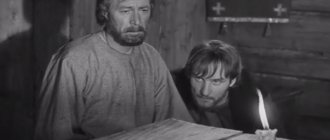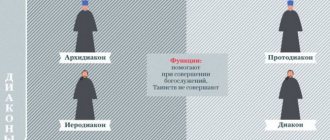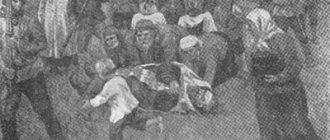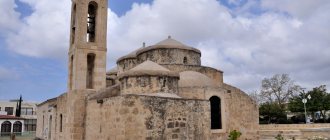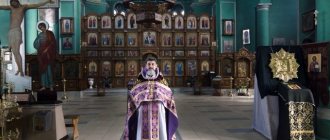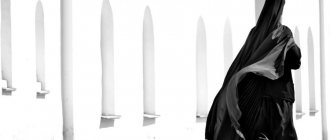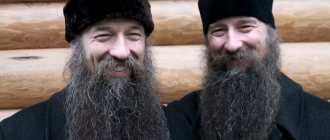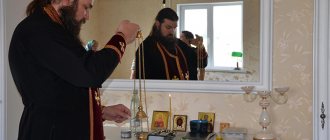Hierarchy of the Russian Orthodox Church
The Russian Orthodox Church, as part of the Universal Church, has the same three-degree hierarchy that arose at the dawn of Christianity.
The clergy are divided into deacons, presbyters and bishops. Persons in the first two sacred degrees can belong to either the monastic (black) or the white (married) clergy. Since the 19th century, our Church has had the institution of celibacy, borrowed from the Catholic West, 1 but in practice it is extremely rare. In this case, the clergyman remains celibate, but does not take monastic vows and does not take monastic vows. Clergymen can only marry before taking holy orders. For the clergy of the Orthodox Church, monogamy is mandatory; divorces and remarriages are not allowed (including for widowers). In schematic form, the priestly hierarchy can be presented as follows (see table).
| Secular clergy | Black clergy |
| I. BISHOP (ARCHIERY) | |
| Patriarch | |
| Metropolitan | |
| Archbishop | |
| Bishop | |
| II. PRIEST | |
| Protopresbyter | Archimandrite 2 |
| Archpriest (senior priest) | Abbot |
| Priest (priest, presbyter) | Hieromonk |
| III. DEACON | |
| Archdeacon (senior deacon serving with the Patriarch) | Archdeacon (senior deacon in the monastery) |
| Protodeacon (senior deacon. Typically in a cathedral) | |
| Deacon | Hierodeacon |
Monk ( Greek
.
μόνος - solitary) - a person who dedicated himself to serving God and took vows (promises) of obedience, non-covetousness and celibacy. Monasticism has three degrees. The ordeal (its duration, as a rule, is three years), or the degree of novice, serves as an entrance into monastic life, so that those who wish for it first test their strength and only after that pronounce irrevocable vows. The novice (otherwise known as the novice) does not wear the full robe of a monk, but only a cassock and a kamilavka, and therefore this degree is also called a cassock, that is, wearing a cassock, so that while awaiting the taking of monastic vows the novice is confirmed on his chosen path. The cassock is a garment of repentance ( Greek
: ράσον - worn, shabby clothing, sackcloth).
Actually, monasticism is divided into two degrees: the small angelic image and the great angelic image, or schema. Dedication of oneself to monastic vows is called tonsure. A cleric can only be tonsured by a bishop, a layman can also be tonsured by a hieromonk, abbot or archimandrite (but in any case, monastic tonsure is performed only with the permission of the diocesan bishop). In Greek monasteries
The tonsure of Holy Mount Athos takes place immediately into the Great Schema.
When tonsured into the lesser schema ( Greek
. τό μικρόν σχήμα - small image) the cassock monk becomes robed: he receives a new name (its choice depends on the tonsure, for it is given as a sign that the monk who renounces the world completely submits to the will of the abbot) and puts on the robes, which marks the “betrothal of the great and angelic image": it has no sleeves, reminding the monk that he should not do the works of the old man; the robe fluttering freely when walking is likened to the wings of an Angel, in accordance with the monastic image. The monk also puts on the “helmet of salvation” (Isa. 59:17; Eph. 6:17; 1 Thess. 5:8) - a hood: just as a warrior covers himself with a helmet when going to battle, so a monk puts on a hood as a sign that strives to turn away his eyes and close his ears so as not to see or hear the vanity of the world.
More strict vows of complete renunciation of the world are pronounced when accepting the great angelic image ( Greek
. το μέγα αγγελικόν σχήμα). When tonsured into the great schema, the monk is once again given a new name. The clothes in which the Great Schema monk dresses are partly the same as those worn by the monks of the Lesser Schema: a cassock, a mantle, but instead of a hood, the Great Schema monk puts on a doll: a pointed cap that covers the head and shoulders all around and is decorated with five crosses located on the forehead, on the chest, on both shoulders and on the back. A hieromonk who has accepted the great schema can perform divine services. A bishop who has been tonsured into the great schema must renounce episcopal power and administration and remain a schema-monk (schema-bishop) until the end of his days.
Deacon ( Greek
. διάκονος - minister) does not have the right to independently perform divine services and church sacraments; he is an assistant to the priest and bishop. A deacon can be elevated to the rank of protodeacon or archdeacon. The rank of archdeacon is extremely rare. It is owned by a deacon who constantly serves His Holiness the Patriarch, as well as deacons of some stauropegic monasteries. A deacon-monk is called a hierodeacon. There are also subdeacons, who are assistants to bishops, but are not among the clergy (they belong to the lower degrees of the clergy along with readers and singers).
Presbyter (from Greek
. πρεσβύτερος - senior) - a clergyman who has the right to perform church sacraments, with the exception of the sacrament of the Priesthood (ordination), that is, the elevation of another person to the priesthood. In the white clergy it is a priest, in monasticism it is a hieromonk. A priest can be elevated to the rank of archpriest and protopresbyter, a hieromonk - to the rank of abbot and archimandrite.
Bishops, also called bishops (from the Greek
. prefixes αρχι. - senior, chief), are diocesan and vicar. The diocesan bishop, by succession of power from the holy Apostles, is the head of the local Church - the diocese, canonically governing it with the conciliar assistance of the clergy and laity. He is elected by the Holy Synod. Bishops bear a title that usually includes the name of the two cathedral cities of the diocese. As needed, the Holy Synod appoints suffragan bishops to assist the diocesan bishop, whose title includes the name of only one of the major cities of the diocese. A bishop may be elevated to the rank of archbishop or metropolitan. After the establishment of the Patriarchate in Rus', only bishops of some ancient and large dioceses could be metropolitans and archbishops. Now the rank of metropolitan, just like the rank of archbishop, is only a reward for the bishop, which makes it possible for even titular metropolitans to appear.
Bishops, as a distinctive sign of their dignity, have a mantle - a long cape fastened at the neck, reminiscent of a monastic robe. In front, on its two front sides, top and bottom, there are sewn tablets - rectangular boards made of fabric. The upper tablets usually contain images of evangelists, crosses, and seraphim; on the lower tablet on the right side are letters; e
,
i
,
m
or
p
, meaning the rank of bishop - bishop, archbishop, metropolitan, patriarch; on the left is the first letter of his name. Only in the Russian Church does the Patriarch wear a green robe, the Metropolitan - blue, archbishops, bishops - purple or dark red. During Great Lent, members of the episcopate of the Russian Orthodox Church wear a black robe. The tradition of using colored bishop's robes in Rus' is quite ancient; an image of the first Russian Patriarch Job in a blue metropolitan robe has been preserved. Archimandrites have a black mantle with tablets, but without sacred images and letters denoting rank and name. The tablets of archimandrite's robes usually have a smooth red field surrounded by gold braid.
During worship, all bishops use a richly decorated staff, called a rod, which is a symbol of spiritual authority over the flock. Only the Patriarch has the right to enter the altar of the temple with a staff. The remaining bishops in front of the royal doors give the rod to the subdeacon - the assistant standing behind the service to the right of the royal doors.
According to the Statute of the Russian Orthodox Church, adopted in 2000 by the Jubilee Council of Bishops, a man of the Orthodox confession at the age of at least 30 years old from among the monastics or unmarried members of the white clergy with mandatory tonsure as a monk can become a bishop. The tradition of electing bishops from among the monastic ranks developed in Rus' already in the pre-Mongol period. This canonical norm is preserved in the Russian Orthodox Church to this day, although in a number of Local Orthodox Churches, for example, in the Georgian Church, monasticism is not considered a mandatory condition for ordination to hierarchical service. In the Church of Constantinople, on the contrary, a person who has accepted monasticism cannot become a bishop: there is a position according to which a person who has renounced the world and taken a vow of obedience cannot lead other people. All hierarchs of the Church of Constantinople are not robed, but robed monks. Widowed or divorced persons who have become monastics can also become bishops of the Russian Orthodox Church. The elected candidate must correspond to the high rank of bishop in moral qualities and have a theological education. The diocesan bishop is entrusted with a wide range of responsibilities. He ordains and appoints clergy to their place of service, appoints employees of diocesan institutions and blesses monastic tonsures. Without his consent, not a single decision of the diocesan governing bodies can be implemented. In his activities, the bishop is accountable to His Holiness the Patriarch of Moscow and All Rus'. The ruling bishops at the local level are authorized representatives of the Russian Orthodox Church before the bodies of state power and administration.
Robe of the Rasophore Monk
The clothes of a cassock monk are a cassock, a cassock and a kamilavka.
A cassock is a black, long, almost to the ground, shirt with narrow sleeves. This robe indicates belonging to the monastic clergy.
The cassock is a casual outer long garment with wide sleeves, which is tightly fastened with a collar. The monks' cassock is also black. The cassock and cassock are a symbol of inner peace, dispassion and detachment from worldly vanity.
The headdress of a ryassophore monk is a kamilavka (also called a hood), which has the shape of a cylinder extended upward. This is the spiritual “helmet of salvation” and “veil of obedience.” Representatives of the white clergy can also have a kamilavka. They receive it as a reward. Unlike monastic ones, the color of the kamilavka is purple.
How are white clergy different from black clergy?
The white clergy includes married clergy who did not take monastic vows. They are allowed to have a family and children.
When they talk about the black clergy, they mean monks ordained to the priesthood. They devote their entire lives to serving the Lord and take three monastic vows - chastity, obedience and non-covetousness (voluntary poverty).
A person who is going to take holy orders is required to make a choice even before ordination - to marry or become a monk. After ordination, a priest can no longer marry. Priests who did not marry before being ordained sometimes choose celibacy instead of becoming a monk—they take a vow of celibacy.
Church hierarchy
In Orthodoxy there are three degrees of priesthood. At the first level are deacons. They help conduct services and rituals in churches, but they themselves cannot conduct services or perform sacraments. Church ministers belonging to the white clergy are simply called deacons, and monks ordained to this rank are called hierodeacons.
The second degree of priesthood is priests. They can independently conduct services, as well as perform most of the sacraments, except for the sacrament of ordination to the priesthood. If a priest belongs to the white clergy, he is called a priest or presbyter, and if he belongs to the black clergy, he is called a hieromonk.
A priest can be elevated to the rank of archpriest, that is, senior priest, and a hieromonk - to the rank of abbot. Often archpriests are the abbots of churches, and abbots are the abbots of monasteries.
The highest priestly rank for the white clergy, the title of protopresbyter, is awarded to priests for special merits. This rank corresponds to the rank of archimandrite in the black clergy.
Only a clergyman belonging to the black clergy can become a bishop. A priest who has been married can be elevated to the rank of bishop only if he becomes a monk. He can do this if his wife has died or has also become a nun in another diocese.
The local church is headed by the patriarch. The head of the Russian Orthodox Church is Patriarch Kirill . In addition to the Moscow Patriarchate, there are other Orthodox patriarchates in the world - Constantinople , Alexandria , Antioch , Jerusalem , Georgian , Serbian , Romanian and Bulgarian .
Priestly ranks of white and black clergy
White clergy are married clergy. Black is monks in the priesthood. There are three hierarchical levels of the priesthood and each of them has its own hierarchy: deacon, priest, bishop. Either a married priest or a monk can be a deacon and a priest. Only a monk can become a bishop.
The Sacrament of the Priesthood is performed only when the candidate is elevated to the next of the three levels. As for the hierarchy of titles within these levels, in ancient times they were associated with special church obediences, and now - with administrative power, special merits, or simply the length of service to the Church.
I. Bishops (bishops) - the highest sacred rank
Bishop - supervising bishop
Archbishop - the most emeritus bishop
Metropolitan - bishop, head of the metropolis
Vicar - assistant to another bishop or his vicar
The Patriarch is the chief bishop in the Local Church
II. Priests - the second sacred order
The word "priest" has several Greek synonyms:
For the white priesthood:
1) Priest (priest; from Greek hieros - sacred) / Presbyter (from Greek presbyteros, literally - elder).
2) Archpriest (first priest) / Protopresbyter (first elder).
For the black priesthood:
1) Hieromonk - a monk in the rank of priest.
2) Archimandrite - (from the Greek archon - head, elder and mandra - sheepfold; literally - elder over the sheepfold), that is, the elder over the monastery. The word “mandra” was used to describe monasteries in Greece. In ancient times, only the abbot of one of the largest monasteries (in the modern Church of Constantinople and Greece this practice is preserved, however, an archimandrite can be both an employee of the Patriarchate and an assistant to the bishop). In modern practice of the Russian Church, the title can be given to the abbot of any monastery and even simply to abbots for special merits and after a certain period of service to the Church.
Clergy towards the end of the 17th century
By the end of the 17th century, the clergy was one of the most powerful, rich and numerous. In essence, the church and monasteries lived according to their own laws. There was no state control over the clergy. The Monastic Order, the only restriction on the rights of the church, ceased to exist during the reign of Alexei Mikhailovich. But still, the clergy was forced to recognize the supremacy of secular power.
Literature:
- Smolich I.K. History of the Russian Church. 1700-1917. M., 1996. Part 1
- Stefanovich P. S. Parish and parish clergy in Russia in the XVI-XVII centuries. M., 2002
5/5 — (1 vote)
Clergy
The Orthodox clergy is a special class that appeared in Rus' in 988, after the Baptism of Rus'. History is silent about how the situation with the clergy was before this period, but it is known that the priest Gregory traveled with Princess Olga to Constantinople. At a time when the clergy was entrusted with a special and very important mission - the Christianization of the population, priests were considered a special and privileged class. Many came from Greece and Bulgaria; even children from different classes were selected for education as the future clergy. The monks enjoyed special honor and respect, and the ascetic culture turned out to be especially close to the people. Rich and noble people of that time went to the monastery. In addition, monasteries have always carried out charitable work. The princes favored the monasteries and freed them from taxes. No exact information has been preserved about who became the first Metropolitan of Kyiv. Since the 16th century, it was believed that he was Michael I the Syrian, who was once sent to perform the Sacrament of Baptism over Prince Vladimir. In Kyiv, he baptized local residents. The relics of Metropolitan Michael were kept in the Church of the Tithes, but then they were transferred to the Great Church of the Lavra.
Monastic robes
Cassock
- a long robe that covers the body with long narrow sleeves. With its simplicity it symbolizes poverty, humility, renunciation of the world, chastity. There are styles of cassocks (read more about them in the section of our directory dedicated to clothing for clergy). Men's and women's monastic cassocks are the same in essence, but when sewing them, it is important to take into account the difference in the cutting of clothes for representatives of different sexes. In an official setting and in church, monastics wear a cassock; in everyday life, especially in the summer heat, in some monasteries other colors are allowed).
Hierarchy of the white clergy
It is worth noting that the hierarchy of the clergy did not appear since the advent of the Church. At the dawn of Christianity, everyone was equal. Gradually, the need to distinguish between church titles and ranks became obvious. In the Russian Orthodox Church you cannot immediately “come to the position” of Metropolitan or Bishop. Such titles must be earned. We will tell you more about the role each clergy rank plays in the life of the Church in this article.
At the head of the Russian Orthodox Church is the Primate - the Patriarch of Moscow and All Rus'. Together with the Holy Synod, it administers church affairs.
The Metropolitan is immediately responsible for several dioceses. Bishops do not make important decisions without the knowledge of the Metropolitan.
Each diocese has its own Bishop, who is responsible for the area assigned to him. Absolutely all bishops belong to the black clergy. Bishops are responsible for large dioceses.
Next in seniority are the priests and archpriests. Archpriest - a priest who has received a special award. Through the sacrament of consecration, priests receive a new status.
There are also deacons and protodeacons who assist the priest and archpriest during services. A deacon cannot conduct divine services on his own.
Thus, the hierarchy in the white clergy looks like this:
- Patriarch
- Metropolitan
- Bishop/Bishop
- Priest/Archpriest
- Deacon/protodeacon
Symbolism of monastic robes
According to the Regulations on Monastics of the Russian Orthodox Church, “monasticism is a special way of Christian life, which consists in completely dedicating oneself to serving God.”
Anyone who wants to devote himself to God in monasticism goes through several degrees of dedication, each of which corresponds to a special robe, and with each new degree the number of these attire increases: new ones are added to the existing ones. Monastic robe
is a sign of dedication, of self-denial to Christ, just as at a wedding crowns are placed on those entering into an earthly marriage.
Black
the color of the monastic robe symbolizes repentance, renunciation of the world, dying for everything worldly in order to come to life for God.
As a rule, monastics (except for schema monks) put on all their vestments only for divine services and on especially solemn occasions. Outside of the service, nuns and nuns wear a cassock, a belt and an apostolic plate, sometimes a skufia is added to them. Monks and monks wear a cassock, belt and skufya
.
Hierarchy of the black clergy
The black clergy has its own rules:
The Patriarch is still considered the head of the Church. And the head of several dioceses is the Metropolitan. A diocese can be headed by a bishop or archbishop (for the largest dioceses). The abbot of a large monastery and the highest monastic rank is the Archimandrite. This status is given for special services to the Church. The abbot of the monastery, chosen by the hieromonks, is the abbot. Interestingly, a widower priest can also become an archimandrite after monastic tonsure. The inhabitants of the monasteries are Hierodeacons and Hieromonks.
- Patriarch
- Metropolitan
- Bishop
- Archimandrite/Hegumen
- Hierodeacon/Hieromonk.
There are other people in the Church who take part in worship, but are not classified as clergy:
- Altar boy
- Acolyte
- Sexton
- Reader
They do not have the grace of the priesthood.
There is no place for competition in the Church and division into higher and lower church ranks speaks only of special merits before God, the Church and people. Everyone has their place in the temple. Anyone can serve in a church as a reader or sexton if they make an effort.
Some of the clergy are also involved in caring for a certain group of people: the military, hospital and hospice patients. Regardless of their “specialization” and rank, the clergy of the Russian Orthodox Church performs important tasks.
Estate structure
In the 17th century, the clergy was considered the second most important among all classes. Only the feudal lords were more powerful. The role of the clergy was very serious. Orthodoxy was considered one of the foundations of autocracy, so the Russian tsars needed the support of the church. In this regard, they provided many privileges and made many concessions.
By this time the clergy was divided into black and white. The latter consisted of priests who did not take monastic vows. In other words, he had the right not to remain celibate and could marry and have children. Representatives of the black clergy - monks - were deprived of this opportunity. The clergyman made such a decision independently and, before taking the rank, finally confirmed his intentions. Each branch had certain rights and responsibilities. The white clergy outnumbered the black clergy. Also, by the end of the 17th century, a strict hierarchical ladder in the class had developed.
For the white clergy it looks like this:
- Patriarch
- Metropolitan
- Bishop/Bishop
- Priest/Archpriest
- Deacon/Protodeacon.
For black:
- Patriarch
- Metropolitan
- Bishop
- Archimandrite/Hegumen
- Hierodeacon/Hieromonk
As a result, both white and black clergy submitted to the Patriarch. He had unlimited rights.
Rights of white and black clergy
The priests had the right:
- get married and have families;
- have a personal home and household;
- serve in a specific church. In the 17th century, very often ministry in a particular church was inherited from father to son.
Rights of monks:
- live and work on the territory of the monastery;
- use common property, monastery lands and serfs. When taking monastic orders, clergy lived in the brethren and did not have personal material or land wealth.
Responsibilities
The white clergy was obliged to preach the word of God and bring it to the masses. In other words, conduct services in the temple, talk with parishioners. Also, the duties of the priests included conducting sacred sacraments.
It was the responsibility of the black clergy to set an example of service to God that was selfless and voluntary. The monks doomed themselves to an ascetic lifestyle with hardships and constant prayers.
Clergy white and black
The Russian Orthodox Church traditionally divides the clergy into two categories: white and black.
The first category includes those priests who did not take the monastic vow, the second includes those who took it. Taking the vow occurs at the time of becoming a monk. Before taking holy orders, a person must decide who he wants to be: a priest (they are allowed to have a wife) or a monk. Once ordination is completed, marriage becomes impossible for the priest. In addition, there is a vow of celibacy. It means complete celibacy. Religion allows priests and deacons to have a spouse, but the hierarch must be a monk. In Orthodoxy there are three hierarchical ranks:
- diaconate;
- priesthood;
- bishopric.
During services, priests are assisted by deacons. However, the latter are deprived of the right to conduct them without the participation of a priest, who, in turn, can perform almost all the sacraments. Bishops carry out ordination to the priesthood; in their hands is all the power that the church can give to a person. This is the highest degree of priesthood.
At the base of the hierarchical ladder are bishops, followed by archbishops in increasing power, then the metropolitan and, finally, the patriarch.
Secular clergy
The white clergy is the largest, comprising the vast majority of the clergy. However, it is also closest to worldly life. In our state, small churches have been built in almost all, even small, settlements. If the parish is small, there is one priest per parish. In a larger parish, an archpriest, a priest and a deacon are needed for pastoral service. In many ways, the position of the clergy depends on the participation and help of the laity. The hierarchy here is not very complicated.
Altar servers
At the altar, the priest also needs help, and he receives it from novices, who are called sextons, or altar servers. Not only men can play this role. Often these functions are taken on by nuns or elderly parishioners. Temples generally have a need for male believers who would like to take on the responsibility of serving God in this way.
To become a sexton, you do not need to go through the ritual of the sacrament. It is enough to receive a blessing to serve from the rector of a particular temple. Responsibilities of the altar server:
- make sure that lamps and candles are burning at the iconostasis, arrange them;
- prepare the priest's vestments;
- bring wine, prosphora and incense on time;
- during communion, bring a cloth with which to wipe your lips;
- maintain order in the altar.
Black clergy
The decision to lead a monastic lifestyle is one of the most difficult in a person’s life. Therefore, before becoming a monk, you must go through novitiate. This is preparation, primarily moral, for dedicating your entire life to the Lord. During this time, you can get used to monastic life and reflect on the necessity of the vow.
After tonsure, a person is given a new name. From that moment on, he was called “Rassophore”, or “monk”. When he accepts the minor schema, he is called a monk, at which time his name changes again and he takes on additional vows.
When accepting the great schema, the monk turns into a schemamonk, his vows become even more strict and his name changes again. Usually schemamonks do not live with the monastery brethren. Often they go into hermitage or become hermits or hermits. They are the ones who perform famous monastic feats.
Hierodeacons and hieromonks
A monk who has accepted the rank of deacon becomes a hierodeacon. If he has the rank of priest, then it is correct to call him a hieromonk. In this case, the title is obtained upon completion of the consecration procedure. White priests can become hieromonks only after monastic tonsure.
Abbots
The abbots of monasteries are called abbots. To become one, you must go through the procedure of election among the hieromonks.
Archimandrites
These clergy belong to one of the highest Orthodox monastic ranks. As a rule, it is issued to the abbots of large monasteries.
It is interesting that archpriests can also become archimandrites: in the event of the death of their mother and when deciding to lead a monastic lifestyle.
Bishops and archbishops
The leadership of dioceses is available to bishops who are ranked among the first rank of bishop. Large dioceses are headed by archbishops. The latter title is considered honorable and can be awarded to those who have great merits before God and the church.
Metropolitan
Several dioceses located in one district or in one region are presided over by a metropolitan.
Patriarch
Patriarchs belong to the highest rank of bishops; they head local churches. Only a person who is the head of an autocephalous church can be ordained. In Russia, the current representative of this rank is Patriarch Kirill.
Black and White Clergy: Serving God
The first representatives of the clergy in Rus' appeared during its baptism under Prince Vladimir. And for more than 1000-
Over the course of history, the Orthodox clergy became a fairly prominent class, especially before the revolution. Indeed, during the years of Soviet power, a very large number of clergy died in the camps. At the end of the last century, churches, monasteries, and seminaries began to open, and the number of clergy began to increase again. The clergy in the Russian Orthodox Church is divided into white (priests who have not taken monastic vows) and black (monastics). Monks take vows when they take vows. Before a person takes holy orders, he must decide whether he will become a monk or a married priest. After all, according to the rules, after ordination a priest can no longer marry. Celibacy is also possible - a vow of celibacy. In Orthodoxy, deacons and priests can be both married and monastics, while hierarchs can only be monastics. Orthodoxy has three ranks of hierarchy: diaconate, priesthood, and bishopric. Deacons are assistants to priests and bishops during divine services. But they themselves have no right to perform any sacrament without priests. Priests are clergy who have the right to independently perform almost all the sacraments (except for ordination to the priesthood - this is the prerogative of the bishop). Bishops are clergy of the highest degree of priesthood who have full power in the Church. The hierarchical ladder is as follows: bishop, archbishop, metropolitan, patriarch.
White clergy ranks
Representatives of the white clergy are closer to the laity, and in number they make up approximately three-quarters of the entire clergy. In almost every village there is an Orthodox church operating or being revived, while in cities there are several dozen parish churches. If the parish is small, then one priest serves. In large parishes, pastoral service is carried out by an archpriest, a priest, and a deacon. The clergy are helped by the laity. An altar boy is a man who helps the priest at the altar (another name is sexton, novice). Nowadays, his duties can be performed either by nuns or elderly single women due to the fact that there are not always believing men who want to serve the Lord in this way. Altar servers do not go through the sacrament, the rector simply blesses them to serve: to light candles and lamps in the altar and at the iconostasis in time, prepare vestments, bring prosphora, wine, incense, light the censer, serve cloths for wiping lips during Communion, tidy up the altar. Psalmist (or reader) is a rank of clergy that does not have the degree of priesthood. Readers read the Holy Scriptures and prayers aloud during the service. If necessary, abbots can give other obediences to the readers. In Orthodoxy, a layman, before becoming a reader, undergoes hirothesia - a rite of initiation into a bishop. Without this first ordination one cannot become a subdeacon, be ordained a deacon, and then a priest. A subdeacon is a clergyman who usually serves the bishop during his sacred rites: he carries candles, spreads the eagle, washes the bishop’s hands, and clothes. The subdeacon does not have a sacred degree, although he wears a surplice and wears an orarion - an accessory to the deaconate, symbolizing angelic wings. Deacon is the first degree of priesthood. Deacons assist priests during divine services, but do not have the right to perform the service themselves. Currently, not all churches have deacons; it is difficult for a small parish to support a large clergy. Protodeacon is the chief deacon in the cathedral. The title can be given after 20 years of service in the priesthood. Priest is the first title of a clergyman; the priest received the power to teach Orthodoxy to his flock, perform the Sacraments (except for the ordination of priests), and conduct services, including the Liturgy (except for the consecration of the antimension). Archpriest is a title given to a priest as a reward. The initiation into archpriest is carried out by the bishop during consecration. Protopresbyter is the highest rank of the white clergy. In the Russian Orthodox Church, this rank is awarded for special merits by decision of the Patriarch.
Black clergy ranks
Before becoming a monk or being tonsured, a person who has decided to devote his life to God undergoes novitiate, that is, preparation for tonsure, getting used to monastic life. The novice has no vows yet. After tonsure, a person takes a different name, becomes a ryassophore, or monk, and takes a vow of obedience. The monk, after accepting the minor schema, becomes a monk, again changing his name and taking the corresponding vows. Next, the monk, having accepted the great schema, becomes a schemamonk, receives a different name, takes other, stricter vows, and more often lives separately from the brethren of the monastery. From the schemamonks come hermits, hermits, hermits and other performers of monastic feats, great prayer books. Hierodeacon is a monk in the rank of deacon. Hieromonk is a monk who has the rank of priest. A monk can become a hieromonk only through ordination, and a white priest can only become a monk by taking monastic vows. Hegumen is the abbot of the monastery, he is elected from among the hieromonks. Archimandrite is a monastic rank, one of the highest in the Russian Orthodox Church, usually the abbot of a large monastery. Bishop is the first rank of bishop; he heads a diocese; Archbishop heads a large diocese; sometimes this honorary title is awarded for great services to the Church. A metropolitan is the head of a large region or district, which includes two or three dioceses. Patriarch is the highest episcopal rank awarded to the head of an autocephalous church. The Primate of the Russian Orthodox Church is Patriarch Kirill. Regardless of rank, representatives of both white and black clergy, in their service to God, teach spiritual children the Orthodox faith and life according to the commandments of God, bring the Good News to the world, enlightening everyone who is able to hear them, and having heard them, follow the commandments in life.
Features of tonsure as a monk
Monasticism is a special way of life for the sake of serving God. Monks have many differences from white clergy. The tonsure can be called the second baptism, because through it a person’s soul is renewed and reborn. After the ceremony, the person is considered to have renounced the world and is henceforth clothed in the image of an angel.
But becoming a monk is not so easy. It is not enough to simply make this decision; you need to justify it and go through a kind of probationary period. During it, the candidate goes through the so-called “monastic work,” which includes three steps:
- the life of a worker;
- the title of candidate for novitiate;
- novitiate.
The difference between the steps is great. Every believer who goes to church can work in it if he has a desire to work for the glory of God. Workers may have families and children. In some cases, they are even paid wages. But if such a person - a servant - lives at a monastery, then he takes upon himself the obligation to comply with the rules adopted there and give up harmful habits.
Upon entering a monastery, a person receives the title of candidate novice. From this moment on, he must begin to figure out how monastic life suits him. The confessor, as well as the abbot of the monastery and the elder brothers, independently determine how long he will remain in the monastery in this capacity.
A novice becomes one who has successfully completed the probationary period, still expresses a desire to live in the monastery, and who is not restrained by any external obstacles. To do this, you need to write a petition to the ruling bishop, which accompanies the letter on behalf of the rector. The diocesan authorities must give their blessing, after which the brother can become a resident of the monastery.
Types of tonsure in monasticism
There are three types of monastic tonsure accepted in Orthodoxy. In accordance with them, monks become:
- ryassophores;
- those who have passed through the small schema;
- those who have passed through the great schema.
Rassophors undertake to live in a monastery for at least three years. Only in the case of a terminal illness can a candidate write a petition to be tonsured a monk before three years have passed.
During the sacred rite, special prayers are read, hair is cut with the help of a cross, the old name is changed (although in some cases the tonsured person can keep his old one), and the person is dressed in a cassock. During tonsure there is no need to pronounce vows, but the very fact of freely entering the path of a monk implies taking on obligations before the Lord. These obligations mean, first of all, the so-called pure living. The intercession of the saint whose name is taken during the ritual helps with this.
Some monasteries skip the stage of the cassock ceremony and immediately perform the sacrament of the minor schema. There is evidence of believers who immediately accepted the great schema. This means maintaining an individual approach to each believer in the Orthodox tradition. It is during the small and great schema that people who become monks make vows to God and renounce worldly life. From this moment on, they not only have a new name and vestments, but also a new life.
Despite these differences, clergy of both types of clergy have a common task: to teach children and adults Orthodoxy and the right life, to educate and bring good. Both white and black clergy are a very important part of serving God, and not only Orthodoxy, but also Catholicism has this system.
Monk weapons
For a truly monastic life, it is necessary to fulfill the prayer rule.
“The rule is the breathing of a monk, this is his daily meeting with the Lord and Teacher, Who Himself comes to visit him. The rule is the obligatory service of a monk, called to intercede with his prayer for the whole world” (Archimandrite Elijah Rago).
Since the time of the first Egyptian monks, the practice of constantly performing a prayer, called in Greek “monologistos” (a prayer consisting of one phrase), has been preserved. This is how the Jesus Prayer became widespread among monastics. It includes the name of the Savior and is usually associated with the publican's prayer:
